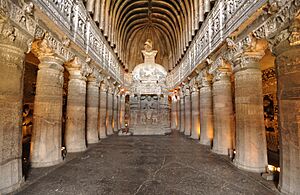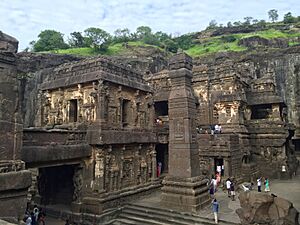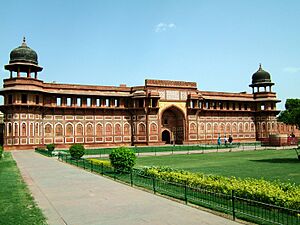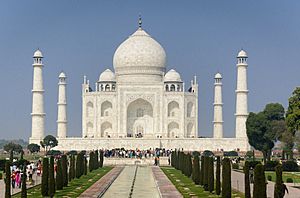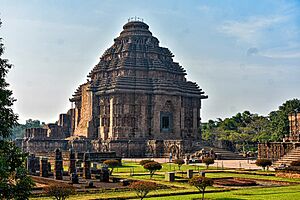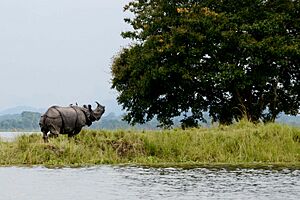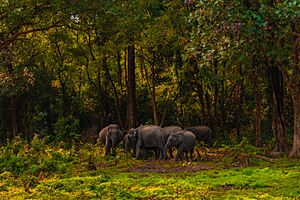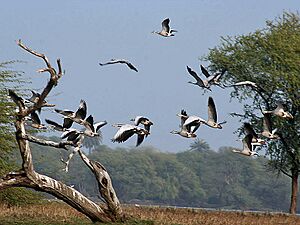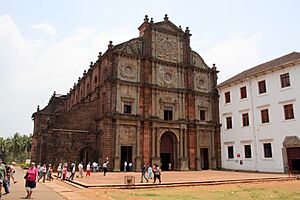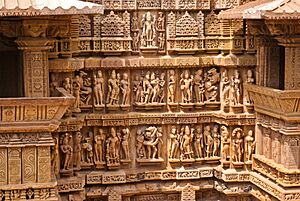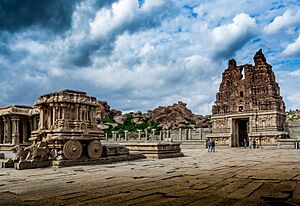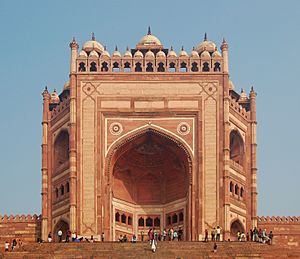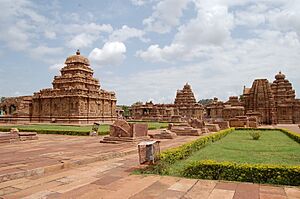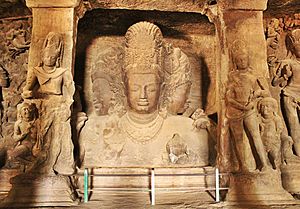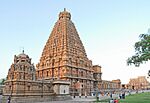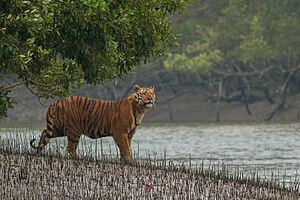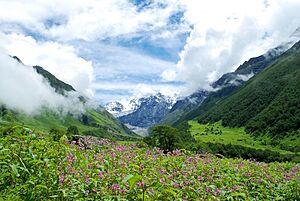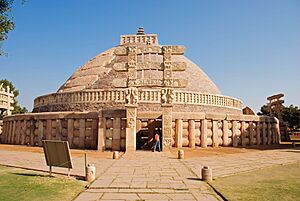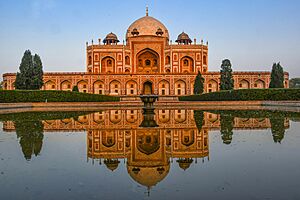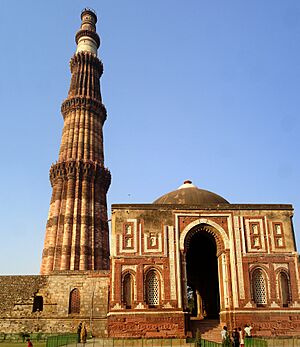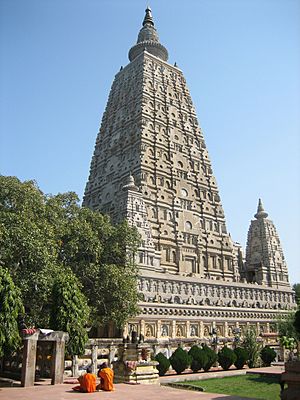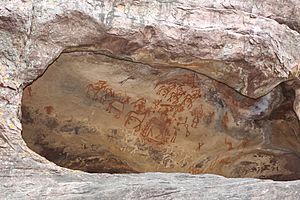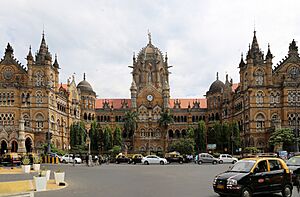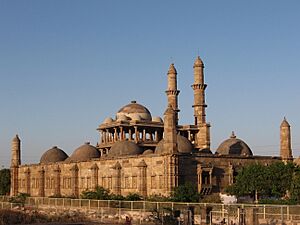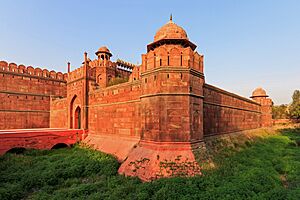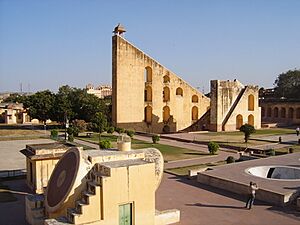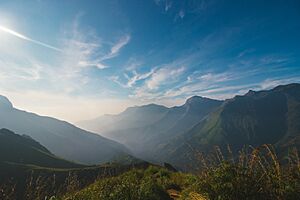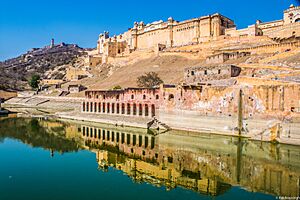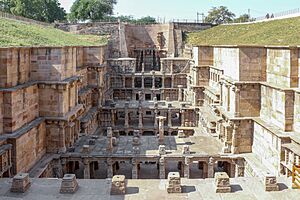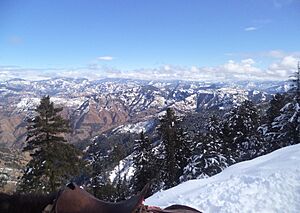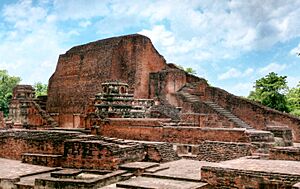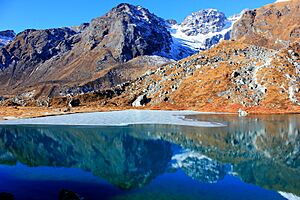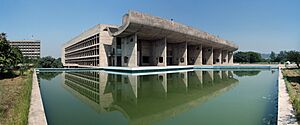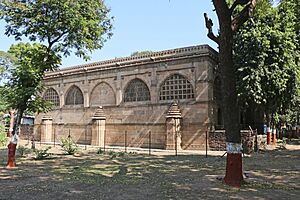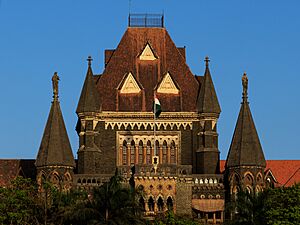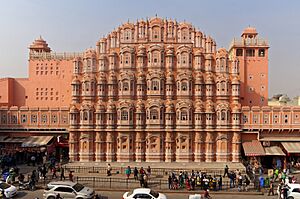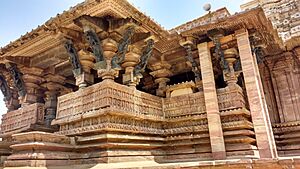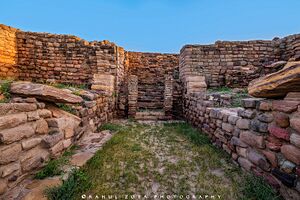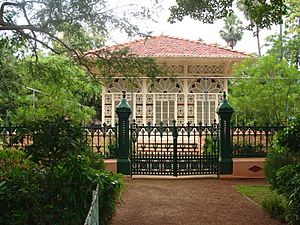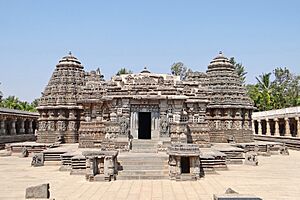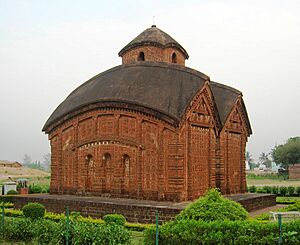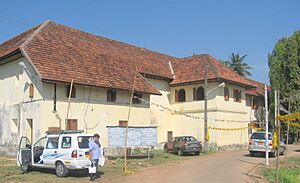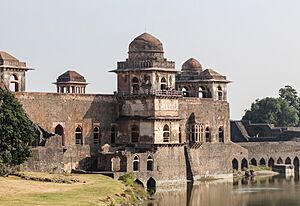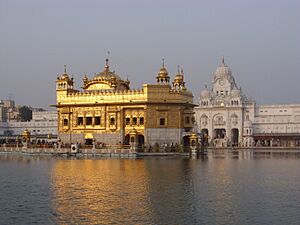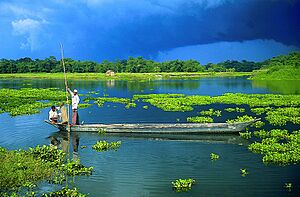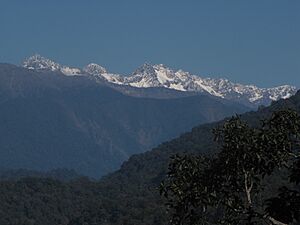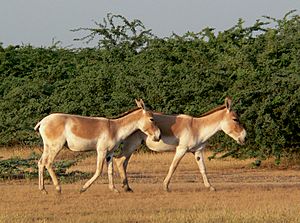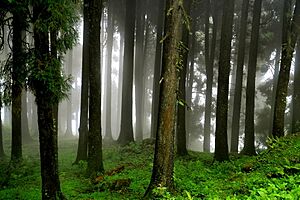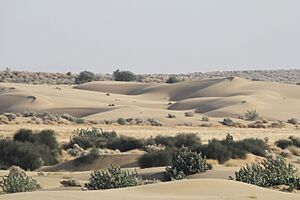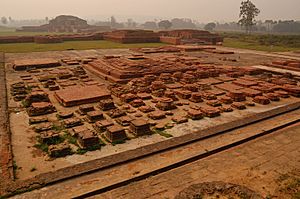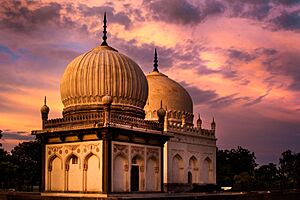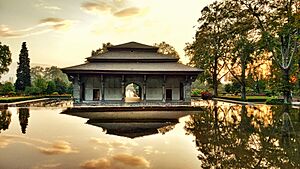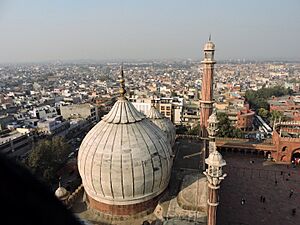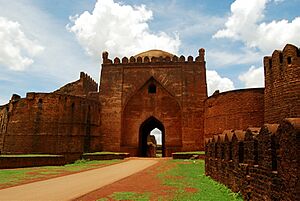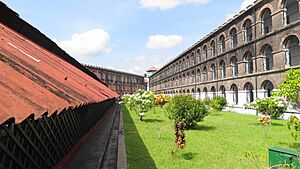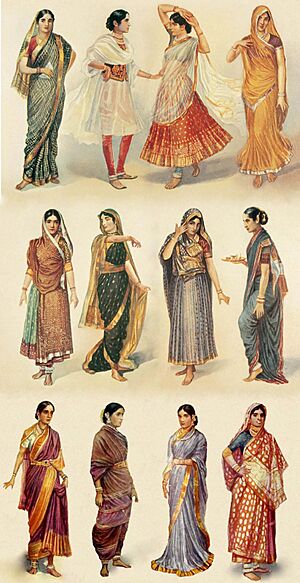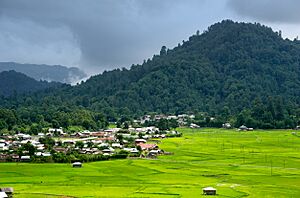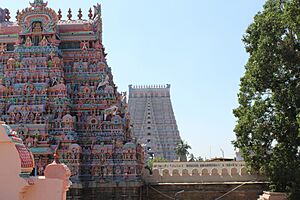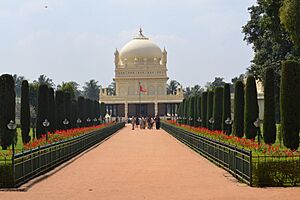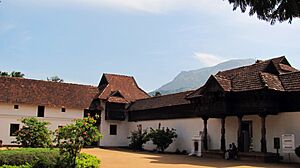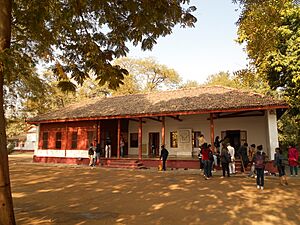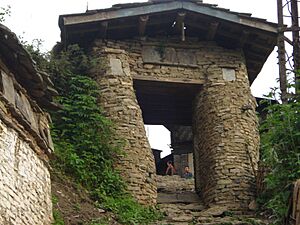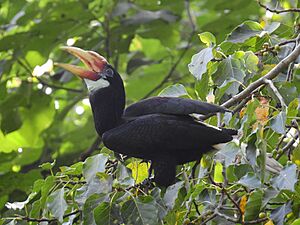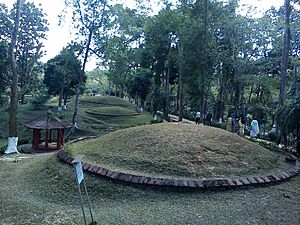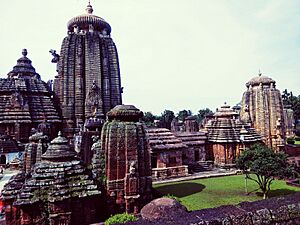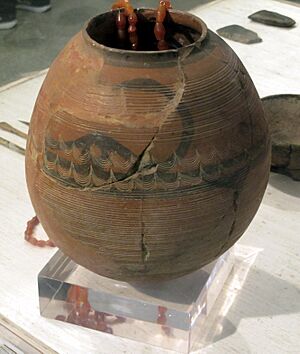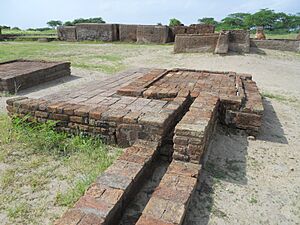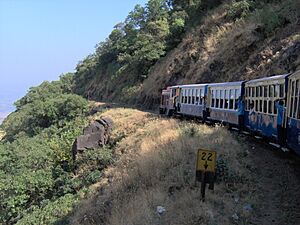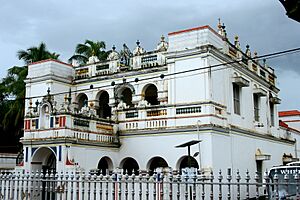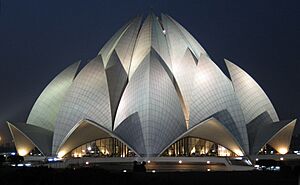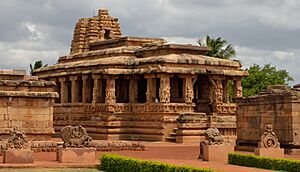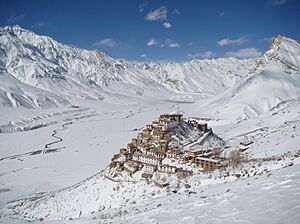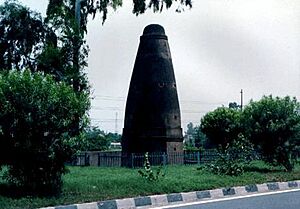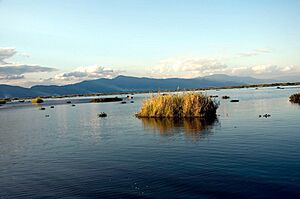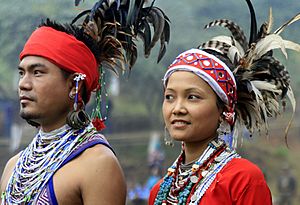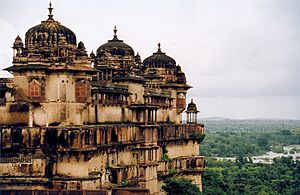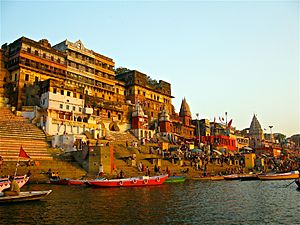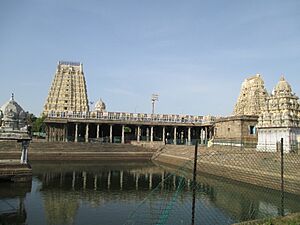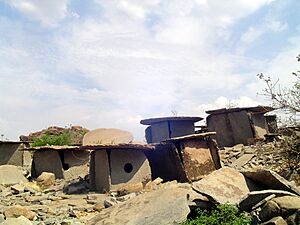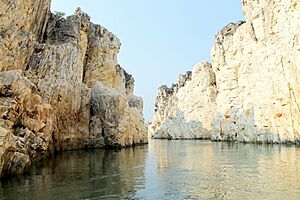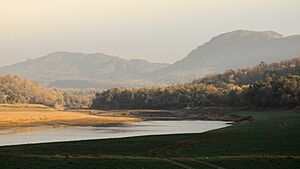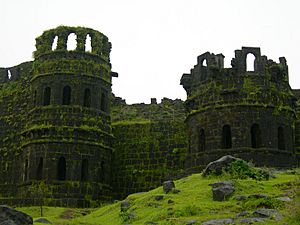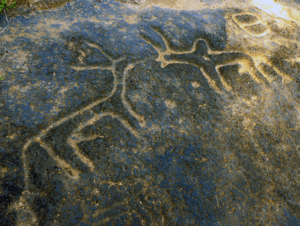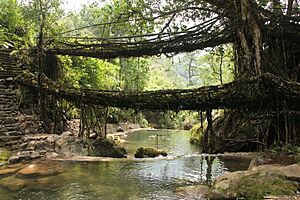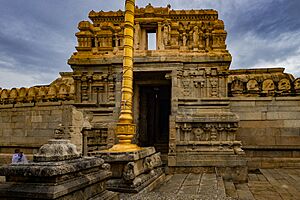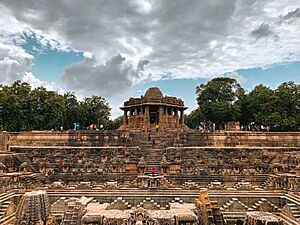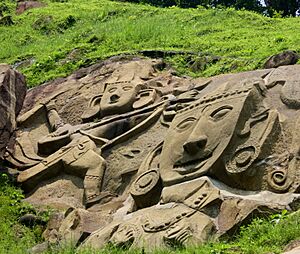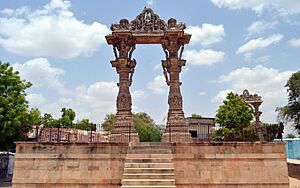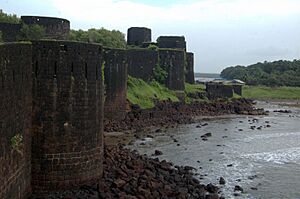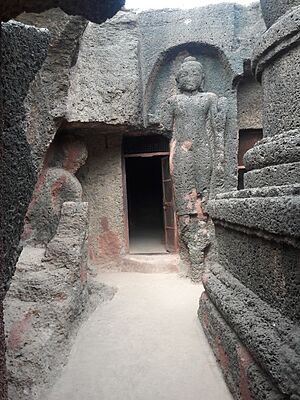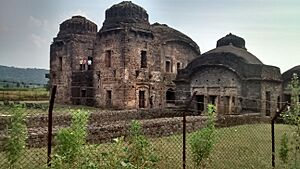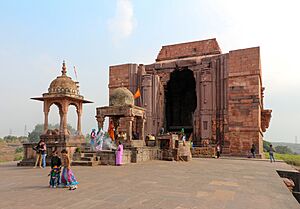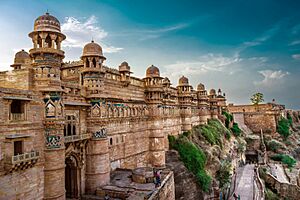List of World Heritage Sites in India facts for kids
The United Nations Educational, Scientific and Cultural Organization (UNESCO) helps protect important places around the world. These places are called World Heritage Sites. They are chosen because they have amazing cultural or natural value. Cultural sites include old buildings, sculptures, and archaeological areas. Natural sites are special places like mountains, forests, or homes for rare animals and plants.
India agreed to protect these sites in 1977. Now, India has 42 World Heritage Sites. Most of them (34) are cultural sites, like ancient temples or forts. Seven are natural sites, such as national parks. One site, Khangchendzonga National Park, is special because it has both cultural and natural importance. India has the sixth-highest number of sites globally.
The first sites listed in India in 1983 were the Ajanta Caves, Ellora Caves, Agra Fort, and Taj Mahal. The newest sites added in 2023 are Santiniketan and the Sacred Ensembles of the Hoysalas. Some sites, like the Manas Wildlife Sanctuary and Hampi, were once in danger but are now safe. One site, The Architectural Work of Le Corbusier, is shared with six other countries. India also has 57 more sites that might become World Heritage Sites in the future.
India's World Heritage Sites
UNESCO uses ten rules to pick World Heritage Sites. Each place must meet at least one rule. Rules 1 to 6 are for cultural sites, and rules 7 to 10 are for natural sites.
* Transnational site
| Site | Image | Location (State) | Year Listed | UNESCO Info | What Makes It Special |
|---|---|---|---|---|---|
| Ajanta Caves | Maharashtra | 1983 | 242; i, ii, iii, vi (cultural) | The Ajanta Caves are a group of ancient Buddhist art. They were carved into rock during two main periods. The first carvings are from around 2nd and 1st centuries BCE. More were added in the 5th and 6th centuries CE. These caves show amazing Buddhist art and influenced art in India and other places like Java. | |
| Ellora Caves | Maharashtra | 1983 | 243; i, iii, vi (cultural) | The Ellora Caves have 34 temples and monasteries carved into a long rock cliff. They were made between the 7th and 11th centuries. These caves were built by followers of Buddhism, Hinduism, and Jainism. This shows how people of different religions lived together peacefully back then. The biggest temple is the Kailasa Temple, which has many detailed sculptures and paintings. | |
| Agra Fort | Uttar Pradesh | 1983 | 251; iii (cultural) | Agra Fort is a large fortress from the 16th century. It was built by the Mughal emperor Akbar. The fort has many palaces, meeting halls, and two mosques. Its style is a great example of Indo-Islamic architecture, mixing Persian and Timurid designs. | |
| Taj Mahal | Uttar Pradesh | 1983 | 252; i (cultural) | The Taj Mahal is one of the most famous buildings in the world. It is a beautiful example of Indo-Islamic architecture. Emperor Shah Jahan built it between 1631 and 1648 for his wife, Mumtaz Mahal. It is made of white marble with precious stones. The complex also has a main gate, a mosque, a guesthouse, and lovely gardens. | |
| Sun Temple, Konârak | Odisha | 1984 | 246; i, iii, vi (cultural) | This Hindu temple was built in the 13th century. It is shaped like the chariot of the sun god Surya. It has 24 carved stone wheels and is pulled by six horses. The temple is also decorated with carvings of lions, musicians, and dancers. | |
| Group of Monuments at Mahabalipuram | Tamil Nadu | 1984 | 249; i, ii, iii, vi (cultural) | These monuments near Mamallapuram were built in the 7th and 8th centuries. They include chariot-shaped temples called rathas, rock-cut temples called mandapas, and large rock carvings. The Shore Temple is one of the famous structures. The art here influenced other places in Asia, like Cambodia and Vietnam. | |
| Kaziranga National Park | Assam | 1985 | 337; ix, x (natural) | Kaziranga is in the flat areas near the Brahmaputra River. It is a top wildlife sanctuary. It has the world's largest number of Indian rhinoceroses. You can also find tigers, Asian elephants, and Ganges river dolphins here. The wet areas are important for many types of birds. | |
| Manas Wildlife Sanctuary | Assam | 1985 | 338; vii, ix, x (natural) | This sanctuary along the Manas River has grasslands and forests. It is a place with many different kinds of plants and animals. It is home to endangered species like the Indian rhinoceros and Asian elephants. The forests here grow back after floods. This site was once in danger due to illegal hunting and local conflicts, but it is now safe. | |
| Keoladeo National Park | Rajasthan | 1985 | 340; x (natural) | Keoladeo was once a hunting area for kings. It is a wetland created and cared for by people. It is very important for many types of birds, both those that live there and those that migrate. More than 350 bird species have been seen here, including Siberian cranes. | |
| Churches and Convents of Goa | Goa | 1986 | 234; ii, iv, vi (cultural) | Old Goa used to be the capital of Portuguese India. This site has seven churches and convents built in the 16th and 17th centuries. They show different European building styles like Gothic and Baroque. These buildings also influenced architecture in other Asian countries. The Basilica of Bom Jesus, where Saint Francis Xavier is buried, is one of them. | |
| Khajuraho Group of Monuments | Madhya Pradesh | 1986 | 240; i, iii (cultural) | This site has 23 temples, both Hindu and Jain. They were built in the 10th and 11th centuries. The temples have many detailed stone carvings and sculptures. These carvings show daily life, musicians, dancers, and loving couples. | |
| Group of Monuments at Hampi | Karnataka | 1986 | 241bis; i, iii, iv (cultural) | Hampi was the capital of the Vijayanagara Empire. It was a rich city for about 200 years. It has many monuments in the Dravidian and Indo-Islamic styles. These include religious buildings, palaces, and defense structures. The Vitthala Temple is a famous example. This site was once in danger but is now protected. | |
| Fatehpur Sikri | Uttar Pradesh | 1986 | 255; ii, iii, iv (cultural) | Fatehpur Sikri was the capital of the Mughal Empire for about ten years in the 16th century. It has many monuments and temples in the Mughal style. These include the Jama Masjid and the Panch Mahal palace. | |
| Group of Monuments at Pattadakal | Karnataka | 1987 | 239rev; iii, iv (cultural) | This site has nine Hindu temples and one Jain temple. They were built in the 7th and 8th centuries. They mix building styles from northern and southern India. The Temple of Virupaksha is a key example. | |
| Elephanta Caves | Maharashtra | 1987 | 244rev; i, iii (cultural) | These caves are on Elephanta Island near Mumbai. They were mostly built in the 5th and 6th centuries. The temples are dedicated to the god Shiva. The caves have huge stone carvings, including a famous statue of Trimurti Shiva. | |
| Great Living Chola Temples | Tamil Nadu | 1987 | 250bis; ii, iii (cultural) | This site includes three Hindu temples built in the 11th and 12th centuries. They are excellent examples of Dravidian architecture from the Chola period. They are made of stone and have beautiful sculptures. The Brihadisvara Temple was the first one listed. Two more temples were added later. | |
| Sundarbans National Park | West Bengal | 1987 | 452; ix, x (natural) | This national park is part of the Sundarbans, a huge delta where the Ganges and Brahmaputra rivers meet. It is the world's largest mangrove forest. It is home to many animals, including Bengal tigers, Irrawaddy dolphins, and sea turtles. | |
| Nanda Devi and Valley of Flowers National Parks | Uttarakhand | 1988 | 335bis; viii, x (natural) | This site has two areas in the Himalayas: the Valley of Flowers National Park and the Nanda Devi National Park. It has high mountains and alpine meadows. Many mountain plants grow here. Animals like the snow leopard and brown bear live here. | |
| Buddhist Monuments at Sanchi | Madhya Pradesh | 1989 | 524; i, ii, iii, iv, vi (cultural) | Sanchi is one of the oldest Buddhist holy places. It was important for spreading Buddhism in India. It has remains of stupas, palaces, temples, and monasteries. Most of these are from the 2nd and 1st centuries BCE. | |
| Humayun's Tomb, Delhi | Delhi | 1993 | 232bis; ii, iv (cultural) | This is the tomb of the Mughal emperor Humayun. It was built in the 1560s. It was the first garden tomb in India, with beautiful Persian gardens. This grand building was a step forward in Mughal architecture and inspired the Taj Mahal. | |
| Qutb Minar and its Monuments, Delhi | Delhi | 1993 | 233; iv (cultural) | This complex has several early Islamic monuments from the 13th and 14th centuries. It includes the Qutb Minar, a tall tower, and the Quwwat-ul-Islam Mosque. There are also old tombs and an Iron pillar. | |
| Mountain Railways of India | West Bengal, Tamil Nadu, Himachal Pradesh | 1999 | 944ter; ii, iv (cultural) | This site includes three mountain railways built in the late 1800s and early 1900s. They helped people reach towns in the mountains. Building them involved amazing engineering, like bridges and tunnels. The Darjeeling Himalayan Railway was listed first. The Nilgiri Mountain Railway and the Kalka–Shimla railway were added later. | |
| Mahabodhi Temple Complex at Bodh Gaya | Bihar | 2002 | 1056rev; i, ii, iii, iv, vi (cultural) | This Buddhist temple marks the spot where Buddha is said to have found enlightenment under the Bodhi Tree. The temple you see today was built in the 5th and 6th centuries CE. It is 50 meters tall and made of brick. It greatly influenced architecture for centuries. | |
| Rock Shelters of Bhimbetka | Madhya Pradesh | 2003 | 925; iii, v (cultural) | This site has five groups of rock shelters. They contain rock paintings from ancient times, showing hunter-gatherer societies. Some nearby villages still have similar cultural practices to those seen in the paintings. | |
| Chhatrapati Shivaji Terminus (formerly Victoria Terminus) | Maharashtra | 2004 | 945rev; ii, iv (cultural) | This historic train station in Mumbai was built in the late 19th century. It was designed in the Victorian Gothic style. It mixed European and Indian building ideas. It showed how rich Mumbai was as a major port during British rule. | |
| Champaner-Pavagadh Archaeological Park | Gujarat | 2004 | 1101; ii, iv, v, vi (cultural) | This park has remains from many different time periods. It includes parts of Champaner, a capital city from the 16th century. Important buildings here are the Kalika Mata Hindu temple, Jain temples, and the Jama Mosque. | |
| Red Fort Complex | Delhi | 2007 | 231rev; ii, iii, vi (cultural) | The Red Fort was built by Mughal emperor Shah Jahan in the mid-17th century. It is a top example of Mughal architecture, mixing Indian and Persian styles. Its design influenced many later palaces. It was also where India's independence was first celebrated. | |
| The Jantar Mantar, Jaipur | Rajasthan | 2010 | 1338; iii, vi (cultural) | The Jantar Mantar in Jaipur is India's most important old observatory. It was built in the early 18th century by King Sawai Jai Singh. It has about 20 instruments used to watch stars and planets without telescopes. | |
| Western Ghats | Maharashtra, Karnataka, Kerala, Tamil Nadu | 2012 | 1342rev; ix, x (natural) | The Western Ghats are a mountain range along India's western coast. They are covered with mountain forests. This area has many different kinds of plants and animals. It is home to endangered species like the Bengal tiger and lion-tailed macaque. This site includes 39 separate areas. | |
| Hill Forts of Rajasthan | Rajasthan | 2013 | 247rev; ii, iii (cultural) | This site has six forts: Chittor Fort, Kumbhalgarh Fort, Ranthambore Fort, Gagron Fort, Amber Fort, and Jaisalmer Fort. They were built between the 8th and 18th centuries by Rajput kingdoms. They show a mix of styles and influenced later forts. | |
| Rani-ki-Vav (the Queen's Stepwell) at Patan, Gujarat | Gujarat | 2014 | 922; i, iv (cultural) | Rani-ki-Vav is a beautiful example of a stepwell. This is a special type of well where you go down many stairs to reach the water. It was built in the 11th century. It has seven levels, each with amazing stone carvings. | |
| Great Himalayan National Park Conservation Area | Himachal Pradesh | 2014 | 1406rev; x (natural) | This national park has many different habitats. It goes from high Himalayas peaks to alpine meadows and forests. It has 25 types of forests with rich plant and animal life. It is home to endangered species like the western tragopan and musk deer. | |
| Archaeological Site of Nalanda Mahavihara at Nalanda, Bihar | Bihar | 2016 | 1502; iv, vi (cultural) | Nalanda Mahavihara was an ancient Buddhist learning center. It was built in the 5th century and lasted until the 13th century. The ruins include shrines, stupas, and buildings where students and teachers lived. Its architecture and teaching methods influenced other schools in the region. | |
| Khangchendzonga National Park | Sikkim | 2016 | 1513; iii, vi, vii, x (mixed) | This national park is around Mount Khangchendzonga, the world's third-highest mountain. It is a sacred place in Tibetan Buddhism. The park has many different habitats, from high mountains with glaciers to old forests. It is rich in animal and plant species. | |
| The Architectural Work of Le Corbusier, an Outstanding Contribution to the Modern Movement* | Chandigarh | 2016 | 1321rev; i, ii, vi (cultural) | This site is shared with six other countries. It includes 17 works by the architect Le Corbusier. He was important in the 20th-century Modernist movement. In India, the Chandigarh Capitol Complex is listed. It is the main part of Chandigarh city and shows modern design. | |
| Historic City of Ahmadabad | Gujarat | 2017 | 1551; ii, v (cultural) | The city of Ahmedabad was founded in 1411. Many religions lived here together, creating a unique city. The buildings are often made of timber. The city has old walls, the Sidi Saiyyed Mosque, and many other mosques and tombs. | |
| Victorian Gothic and Art Deco Ensembles of Mumbai | Maharashtra | 2018 | 1480; ii, iv (cultural) | This site has two groups of buildings in Mumbai from the British era. The Victorian Gothic buildings from the 1800s mixed Gothic style with features for the Indian climate, like balconies. The Art Deco buildings from the early 1900s include cinemas and apartments. | |
| Jaipur City, Rajasthan | Rajasthan | 2019 | 1605; ii, iv, vi (cultural) | Jaipur was founded in 1727. The city was built with a grid plan, which was new for the region. It became a strong trade center. Important buildings include the Hawa Mahal palace and the City Palace. | |
| Kakatiya Rudreshwara (Ramappa) Temple, Telangana | Telangana | 2021 | 1570; i, iii (cultural) | This Hindu temple, dedicated to Shiva, was built in the early 13th century. It has stone carvings and sculptures that show local dance customs. The temple's design blends well with nature. | |
| Dholavira: a Harappan City | Gujarat | 2021 | 1645; iii, iv (cultural) | Dholavira was a major city of the Harappan Civilization from 3000 to 1500 BCE. It has remains of a walled city and a cemetery. You can see old buildings and water systems. The city traded with other places, even Mesopotamia. | |
| Santiniketan | West Bengal | 2023 | 1375; iv, vi (cultural) | Santiniketan started as a spiritual retreat in the 19th century. It grew into a university town. It is linked to the famous poet and philosopher Rabindranath Tagore. The prayer hall is a notable building here. | |
| Sacred Ensembles of the Hoysalas | Karnataka | 2023 | 1670; i, ii, iv (cultural) | This site includes three Hoysala temples built between the 12th and 14th centuries. They combine Dravidian architecture with northern Indian styles. The temples are richly decorated with stone sculptures. The Chennakeshava Temple in Belur is still an important pilgrimage site. |
What is on the Tentative List?
Countries can suggest sites for the World Heritage List by putting them on a "tentative list" first. India has 57 places on its tentative list. These are places that might become World Heritage Sites in the future.
| Site | Image | Location (State) | Year Listed | UNESCO Criteria | What Makes It Special |
|---|---|---|---|---|---|
| Temples at Bishnupur, West Bengal | West Bengal | 1998 | (cultural) | These terracotta temples were built in the 17th century. They are made of brick and have unique sloping roofs. The Jor Bangle temple, built in 1655, is a good example. | |
| Mattancherry Palace, Ernakulam, Kerala | Kerala | 1998 | (cultural) | The Portuguese built this palace for local rulers around 1555. It is a two-story building with several halls. Its coronation hall has a ceiling decorated with carvings. | |
| Group of Monuments at Mandu, Madhya Pradesh | Madhya Pradesh | 1998 | (cultural) | This group includes monuments from the 11th to the 16th centuries. They are rock-cut tombs, temples, mosques, and palaces. The Jahaz Mahal palace is a famous part of this site. | |
| Ancient Buddhist Site, Sarnath, Varanasi, Uttar Pradesh | Uttar Pradesh | 1998 | (cultural) | This site has two groups of monuments. The first group includes Buddhist temples, stupas, and monasteries. They date from the 3rd century BCE to the 12th century CE. The Dhamek Stupa is pictured here. | |
| Sri Harimandir Sahib, Amritsar, Punjab | Punjab | 2004 | iii, iv, vi (cultural) | Sri Harimandir Sahib, also known as the Golden Temple, is the main spiritual place for Sikhism. The temple has been rebuilt many times. Its design shows the spiritual ideas of the religion. The main temple is richly decorated with floral patterns. | |
| River Island of Majuli in midstream of Brahmaputra River in Assam | Assam | 2004 | ii, iii, v, vi (cultural) | Majuli is a large river island in the Brahmaputra River. It has over 200 villages with people from different backgrounds. The island has unique cultural centers called satras. | |
| Namdapha National Park | Arunachal Pradesh | 2006 | vii, ix, x (natural) | This national park is a huge wilderness area, mostly covered in forests. It is in the Eastern Himalayas. The highest peak here is Dapha Bum. | |
| Wild Ass Sanctuary, Little Rann of Kutch | Gujarat | 2006 | x (natural) | Little Rann of Kutch is a salt marsh with sparse plants. It is the only place where the Indian wild ass lives in the wild. It is also an important nesting area for birds. | |
| Neora Valley National Park | West Bengal | 2009 | vii, x (natural) | This area is covered by untouched forest and has many different plants and animals. The valley goes from lowlands to high mountains, creating various habitats. It is home to animals like the red panda. | |
| Desert National Park | Rajasthan | 2009 | vii, viii, x (natural) | This national park is part of the Thar Desert. It has unique species like the Indian hairy-footed gerbil. It is also home to two endangered types of vultures. Old fossils from the Jurassic period have been found here. | |
| Silk Road Sites in India | Bihar, Jammu and Kashmir, Maharashtra, Puducherry, Punjab, Tamil Nadu, Uttar Pradesh | 2010 | ii, iii, vi (cultural) | This nomination includes 12 sites linked to the ancient Silk Road. This was a network of trade routes connecting China with the West. These routes helped spread Buddhism and Greco-Buddhist culture. Sites include the Roman trade port at Arikamedu and Vikramashila. | |
| The Qutb Shahi Monuments of Hyderabad Golconda Fort, Qutb Shahi Tombs, Charminar | Telangana | 2010 | i, ii, iii, iv (cultural) | This group includes monuments from the Qutb Shahi dynasty (16th and 17th centuries). The Golconda Fort was an early capital. The Qutb Shahi tombs are burial places for sultans. The Charminar is a grand gateway with four minarets. These sites show the diverse culture of the region. | |
| Mughal Gardens in Kashmir | Jammu and Kashmir | 2010 | i, ii, iv (cultural) | Mughal gardens were designed like Persian gardens, with terraces and fountains. They reflect the Islamic idea of paradise. Six gardens are listed, including Shalimar Bagh. | |
| Delhi - A Heritage City | Delhi | 2012 | ii, v, vi (cultural) | Delhi has been a capital city for a very long time. Different rulers built new cities on the same site. It was the capital of the Delhi Sultanate and the Mughal Empire. Later, New Delhi became the capital under British rule. This nomination lists important historical areas like Mehrauli and Shahjahanabad. | |
| Monuments and Forts of the Deccan Sultanate | Karnataka, Telangana | 2014 | ii, iii (cultural) | This group includes monuments from the Deccan sultanates (14th to 17th centuries). They are found in four cities: Gulbarga, Bidar, Bijapur, and Hyderabad. The architecture mixes Islamic and Hindu influences. The Bidar Fort is one example. | |
| Cellular Jail, Andaman Islands | Andaman and Nicobar Islands | 2014 | iv, vi (cultural) | The British built this jail in 1906 to send political prisoners to a faraway island. Its design allowed one guard to watch many cells. The jail was known for harsh treatment and is important in India's independence story. | |
| Iconic Saree Weaving Clusters of India | Madhya Pradesh, Uttar Pradesh, Maharashtra, Andhra Pradesh, Assam | 2014 | iii, v (cultural) | The Sari is a traditional Indian dress. Weaving saris needed special house designs for looms. This nomination includes eight areas where sari weaving is a main job. Different styles of saris are shown. | |
| Apatani Cultural Landscape | Arunachal Pradesh | 2014 | iii, v (cultural) | Apatani people live in the Ziro Valley, surrounded by mountains. They have a unique culture with traditional crafts. They grow rice in wet fields and manage their land carefully. This landscape shows how they live well in a challenging environment. | |
| Sri Ranganathaswamy Temple, Srirangam | Tamil Nadu | 2014 | i, ii, iii, v (cultural) | The Sri Ranganathaswamy Temple is dedicated to Ranganatha. It is the world's largest working Hindu temple. It's like a temple town itself. The main buildings are from the 14th to 16th centuries. The temple has 21 tall, decorated towers called gopurams. | |
| Monuments of Srirangapatna Island Town | Karnataka | 2014 | i, ii, iii, iv (cultural) | Srirangapatna is an island in the Kaveri river. It has been lived in since the 12th century. The monuments here are from different times, including Hindu, Indo-Islamic, and British styles. The Gumbaz mausoleum is pictured. | |
| Chilika Lake | Odisha | 2014 | ix, x (natural) | Chilika Lake is a large brackish water lagoon. It has different parts that are freshwater, brackish, and marine. It is an important home for birds and mammals, including the endangered Irrawaddy dolphin. | |
| Padmanabhapuram Palace | Tamil Nadu | 2014 | iii, iv (cultural) | This palace was built in the 16th century and added to until the early 19th century. It was the home of the Travancore royal family. It is a great example of traditional timber architecture. It has murals and carvings showing Hindu stories and daily life. | |
| Sites of Satyagrah, India's non-violent freedom movement | several sites | 2014 | iv, vi (cultural) | Satyagraha is a way of protesting peacefully. Mahatma Gandhi developed it in the 20th century for India's independence movement. This nomination includes 22 sites related to this movement. Many are ashrams, where Gandhi taught his ideas. | |
| Thembang Fortified Village | Arunachal Pradesh | 2014 | ii, iii, v (cultural) | Thembang village is in the Eastern Himalayas. It is built like a dzong, a type of fortified monastery. It has been inhabited by the Monpas people since before the 12th century. | |
| Narcondam Island | Andaman and Nicobar Islands | 2014 | viii, ix, x (natural) | Narcondam Island is a volcanic island. It is important for studying how species evolve because it is isolated. It is the only place where the endangered Narcondam hornbill lives. | |
| Moidams – the Mound-Burial system of the Ahom Dynasty | Assam | 2014 | v (cultural) | This nomination includes burial mounds in Charaideo. These mounds were where the royals and nobles of the Ahom kingdom (1228–1826) were buried. They create a hilly landscape that matches the spiritual beliefs of the Tai-Ahom people. | |
| Ekamra Kshetra – The Temple City, Bhubaneswar | Odisha | 2014 | i, ii, iii (cultural) | Ekamra Kshetra is the old part of Bhubaneswar, known as the "Temple City." It once had about 700 temples. These temples were built between the 3rd century BCE and 15th century CE. They show the Kalinga style and belong to Hindu, Buddhist, and Jain religions. | |
| The Neolithic Settlement of Burzahom | Jammu and Kashmir | 2014 | ii, iii, v (cultural) | The archaeological site at Burzahom tells us about how societies developed from 4000 to 1500 BCE. People first lived in pit-houses and later built houses of mud and brick. There are also large stone structures. | |
| Archaeological remains of a Harappa Port-Town, Lothal | Gujarat | 2014 | v (cultural) | Lothal was the only port city of the Harappan Civilization during the Bronze Age. It was used from about 2400 BCE to 1600 BCE. The city had wide streets, a warehouse, and a port. Remains show it traded with the Persian Gulf region. | |
| Mountain Railways of India (Extension) | Maharashtra, Himachal Pradesh | 2014 | ii, iv (cultural) | This is a proposed addition to the existing World Heritage Site. It includes the Matheran Hill Railway and the Kangra Valley Railway. They were built in the early 20th century and show great engineering for mountain terrain. | |
| Chettinad, Village Clusters of the Tamil Merchants | Tamil Nadu | 2014 | ii, v, vi (cultural) | This nomination includes 11 villages. Wealthy merchants built them in the late 19th and early 20th centuries. The villages mix city and country influences, as well as Tamil and Southeast Asian styles. Many grand houses were built using local and imported materials. | |
| Bahá'í House of Worship at New Delhi | Delhi | 2014 | i, v, vi (cultural) | The Lotus Temple is the main Baháʼí House of Worship in India. It opened in 1986. It is shaped like a lotus flower, with petals made of concrete and covered in marble. | |
| Evolution of Temple Architecture – Aihole-Badami-Pattadakal | Karnataka | 2015 | iii, iv (cultural) | This nomination includes several temples in Aihole, Badami, and Pattadakal. They were built between the 6th and 8th centuries. They show how Hindu temple architecture developed from rock-cut to free-standing temples. The Durga Temple in Aihole is pictured. | |
| Cold Desert Cultural Landscape of India | Ladakh, Himachal Pradesh | 2015 | iii, v, vi, x (mixed) | These landscapes in the Himalayas are very high and dry. The culture here mixes Indian and Tibetan traditions. Many settlements are linked to Buddhist monasteries like Key Monastery. The area is also home to endangered animals like the snow leopard. | |
| Sites along the Uttarapath, Badshahi Sadak, Sadak-e-Azam, Grand Trunk Road | several sites | 2015 | ii, iv, vi (cultural) | The Grand Trunk Road is one of Asia's oldest and longest roads. It connects Afghanistan, Pakistan, India, and Bangladesh. It has been used for trade and spreading ideas since ancient times. Many historical sites are found along this road. | |
| Keibul Lamjao Conservation Area | Manipur | 2016 | v, vii, ix, x (mixed) | Loktak Lake is a large freshwater lake with unique floating islands made of soil and plants. It has a mix of water, wetland, and land habitats. It is home to the endangered sangai deer. Some villages are on the lake's shores and even on the floating islands. | |
| Garo Hills Conservation Area (GHCA) | Meghalaya | 2018 | v, vi, viii, x (mixed) | The Garo Hills are home to the Garo people. They practice a type of farming that uses community rules to protect the land. The area is also interesting for its geology and is home to animals like the Asian elephant and red panda. | |
| The historic ensemble of Orchha | Madhya Pradesh | 2019 | ii, iv (cultural) | The town of Orchha was founded in the 16th century. Its palaces, temples, and gardens mix styles from Rajput and Mughal architecture. The Jahangir Mahal is a key part of this site. | |
| Iconic Riverfront of the Historic City of Varanasi | Uttar Pradesh | 2021 | iii, iv, vi (cultural) | Varanasi is a holy city for Hindus, Buddhists, and Jains. More than 80 ghats (steps to the river) line the Ganges river. These are used for rituals and festivals. Varanasi has been lived in since at least 1200 BCE. | |
| Temples of Kanchipuram | Tamil Nadu | 2021 | iv, vi (cultural) | Kanchipuram was the capital of the Pallava dynasty. It is a holy Hindu city that once had hundreds of temples. The architecture here shows the change from rock-cut temples to free-standing buildings. The Ekambareswarar Temple is one of 11 temples listed. | |
| Hire Benakal, Megalithic Site | Karnataka | 2021 | iii, iv (cultural) | Hire Benakal is the largest megalithic site in India. The dolmens here are from 1000 BCE to the Iron Age. They show us about the ancient culture that built India's first large monuments. Rock paintings have also been found. | |
| Bhedaghat-Lametaghat in Narmada Valley | Madhya Pradesh | 2021 | vii, viii (natural) | At Bhedaghat, the Narmada River has carved a canyon through white marble mountains. This creates a beautiful landscape. The Lameta Formation here has many fossils, including those of dinosaurs. | |
| Satpura Tiger Reserve | Madhya Pradesh | 2021 | vii, ix, x (natural) | The forests in the Satpura Range are protected for their large population of tigers. This area connects animal habitats between the Western Ghats and the Himalayas. It also has several endangered plant species. | |
| Serial Nomination of Maratha Military Architecture in Maharashtra | Maharashtra | 2021 | ii, iii, iv (cultural) | This nomination includes 14 forts in Maharashtra. They are built on hills from basalt rocks and were used for defense. Many were built by the Marathi ruler Chhatrapati Shivaji in the 17th century. The Raigad Fort is pictured. | |
| Geoglyphs of Konkan Region of India | Maharashtra, Goa | 2022 | i, iii, iv (cultural) | This nomination has 10 sites with geoglyphs (large designs on the ground) along the Konkan coast. They date from 10,000 BCE to 2000 BCE. They show animals, people, and abstract art. They tell us about the shift from hunter-gatherer societies to settled ones. | |
| Jingkieng jri: Living Root Bridge Cultural Landscapes | Meghalaya | 2022 | i, iii, vi (cultural) | A living root bridge is a bridge made from the roots of living trees. They are carefully shaped over many years by the Khasi people. These bridges show a special connection between people and nature. An example is in Nongriat village. | |
| Sri Veerabhadra Temple and Monolithic Bull (Nandi), Lepakshi (The Vijayanagara Sculpture and Painting Art Tradition) | Andhra Pradesh | 2022 | i, ii, vi (cultural) | This Hindu temple is in Lepakshi. Its construction started around 1100, with major work done during the Vijayanagara Empire (1350-1600). The temple has important examples of Vijayanagara art, including rare frescoes. A large stone bull (Nandi) is also on the temple grounds. | |
| Sun Temple, Modhera and its adjoining monuments | Gujarat | 2022 | i, iv (cultural) | This temple complex is a great example of the Māru-Gurjara style from the 11th century. It is dedicated to the Sun God. It has a shrine hall, an assembly hall, and a water reservoir. | |
| Rock-cut Sculptures and Reliefs of the Unakoti, Unakoti Range, Unakoti District | Tripura | 2022 | i, iv (cultural) | Unakoti has huge rock carvings and sculptures of Hindu gods. They are from the 8th and 9th centuries. They were made by followers of Shaivism and show local folk art styles. | |
| Vadnagar – A multi-layered Historic town, Gujarat | Gujarat | 2022 | ii, v (cultural) | This town has been continuously lived in since 750 BCE. It has monuments like gates, fortresses, and temples from different times. Remains found here show it traded with the Indo-Greek Kingdom and the Roman Empire. | |
| Serial nomination of Coastal Fortifications along the Konkan Coast, Maharashtra | Maharashtra | 2024 | This nomination includes 9 forts along the Konkan coast in Maharashtra. They are important examples of coastal defense architecture. | ||
| The historic ensemble of Dhamnar | Madhya Pradesh | 2024 | The Dhamnar Caves are caves carved into rock. They date back to between the 5th and 7th centuries CE. These caves show ancient art and architecture. | ||
| The Gond monuments of Ramnagar, Mandla | Madhya Pradesh | 2024 | These monuments show the history and culture of the Gond people. The Gonds are one of India's largest native groups. The sites include forts, palaces, and temples. They show the unique art and building styles of the Gond dynasty. | ||
| The Bhojeshwar Mahadev Temple, Bhojpur | Madhya Pradesh | 2024 | This is an unfinished Hindu temple dedicated to Lord Shiva. It was started in the 11th century by King Bhoja. The temple is famous for its huge lingam, one of the biggest in India. It shows amazing building skills from medieval times. | ||
| Rock Art Sites of the Chambal Valley | Madhya Pradesh | 2024 | These sites have ancient paintings and carvings on rocks. They date back to the Mesolithic period. They show scenes from daily life, rituals, animals, and abstract art. They help us understand early human expression and communication. | ||
| Khooni Bhandara, Burhanpur | Madhya Pradesh | 2024 | This is an underground water system from the 16th century. It was built during the Mughal era to supply water to the city. It uses gravity to move water and shows advanced engineering for its time. Much of it still works today. | ||
| Gwalior Fort, Madhya Pradesh | Madhya Pradesh | 2024 | ii, iv (cultural) | This historic fort was built in the 8th century on a sandstone hill. It has palaces, temples, and water tanks. It shows different building styles. The fort is known for its smart design and blue ceramic tile decorations. |
See Also
 In Spanish: Anexo:Patrimonio de la Humanidad en la India para niños
In Spanish: Anexo:Patrimonio de la Humanidad en la India para niños
- List of Intangible Cultural Heritage elements in India
- National Geological Monuments of India
- Monuments of National Importance of India
- List of rock-cut temples in India
- List of forts in India
- List of museums in India
- Tourism in India


